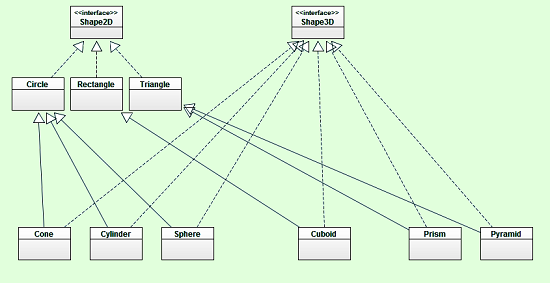VB.Net - OOP Areas and Volumes Calculator
Overview
This is an OOP Areas and Volumes Calculator. It consists of a core containing nine classes representing different geometric shapes. These shapes fall into two categories - 2D and 3D.

Figure 1. Core object diagram showing inheritance and implementation.
There are three classes that represent 2D shapes, that implement the Shape2D Interface. These are:
- Circle - This contains a constructor with one Decimal parameter - r (radius) and implements the getArea function. There are three classes that inherit Circle that implement the getVolume function from the Shape3D Interface, as well as overriding the base class getArea function:
-
- Cone - This contains a constructor with two Decimal parameters - r (radius) and h (height).
- Cylinder - This contains a constructor with two Decimal parameters - r (radius) and h (height).
- Sphere - This contains a constructor with one Decimal parameter - r (radius).
- Rectangle - This contains a constructor with two Decimal parameters - l (length) and w (width) and implements the getArea function.The Cuboid class inherits this class and implements the getVolume function from the Shape3D Interface, as well as overriding the Rectangle class getArea function:
-
- Cuboid - This contains a constructor with three Decimal parameters - - l (length), w (width), and h (height).
- Triangle - This contains a constructor with three Decimal parameters - a (side A), b (side B), and c (side C) and implements the getArea function. There are two classes that inherit the Triangle class, both of which implement the getVolume function from the Shape3D Interface, as well as overriding the Triangle' getArea function:
-
- Prism - This contains a constructor with four Decimal parameters - l (length), a (side A), b (side B), and c (side C).
- Pyramid - This contains a constructor with four Decimal parameters -h (height), b (base length), bc (sides b and c), and s (number of sides).
** **
There is a Calculator class that has a function - calculate, that is passed a className string parameter and a 2D object array parameter containing the contents of the DGV which is used for input. This method coordinates the creation of the shape classes through substitution and reflection and it returns a formatted string containing area and volume (if applicable).
The Calculator class
Public Class Calculator
Dim variablesByName As New Dictionary(Of String, Decimal)
Dim classesByName As New Dictionary(Of String, String)
''' <summary>
''' Sets up the two Dictionary objects
''' </summary>
Public Sub New()
variablesByName.Add( "Length" , 0D)
variablesByName.Add( "Width" , 0D)
variablesByName.Add( "Height" , 0D)
variablesByName.Add( "Radius" , 0D)
variablesByName.Add( "SideA" , 0D)
variablesByName.Add( "SideB" , 0D)
variablesByName.Add( "SideC" , 0D)
variablesByName.Add( "Base" , 0D)
variablesByName.Add( "Sidelength" , 0D)
variablesByName.Add( "Sides" , 0D)
classesByName.Add( "Circle" , "Circle" )
classesByName.Add( "Rectangle" , "Rectangle" )
classesByName.Add( "Triangle" , "Triangle" )
classesByName.Add( "Cone" , "Cone" )
classesByName.Add( "Cylinder" , "Cylinder" )
classesByName.Add( "Sphere" , "Sphere" )
classesByName.Add( "Cuboid" , "Cuboid" )
classesByName.Add( "Prism" , "Prism" )
classesByName.Add( "3 Sided Pyramid" , "Pyramid" )
classesByName.Add( "4 Sided Pyramid" , "Pyramid" )
End Sub
''' <summary>
''' Coordinates creation of classes by substitution and reflection.
''' </summary>
''' <param name="selectedClass"></param>
''' <param name="cells"></param>
''' <returns>A formatted string containing area and volume (if applicable)</returns>
Public Function calculate(selectedClass As String, cells(,) As Object) As String
For x As Integer = 0 To 3
If Not cells(x, 0) Is Nothing Then
If Not cells(x, 1) Is Nothing Then
Dim v As Decimal
If Decimal.TryParse(cells(x, 1).ToString, v) Then
variablesByName(cells(x, 0).ToString) = v
Else
Return ""
End If
Else
Return ""
End If
End If
Next
Dim parameters As New List(Of Decimal)
For Each kvp As KeyValuePair(Of String, Decimal) In variablesByName
If kvp.Value > 0 Then
parameters.Add(kvp.Value)
End If
Next
For Each s As String In variablesByName.Keys.ToList
variablesByName(s) = 0D
Next
Dim aClass As Shape2D = DirectCast(Activator.CreateInstance(Type.GetType("OOP_Areas_and_Volumes." & classesByName(selectedClass)), parameters.ConvertAll(Function(d) CObj(d)).ToArray), Shape2D)
Dim msg As String = $"Surface area: {aClass.getArea:n2}²"
Dim aClass2 As Shape3D = TryCast(aClass, Shape3D)
If aClass2 IsNot Nothing Then
msg &= $ "{Environment.NewLine}Volume: {aClass2.getVolume:n2}³"
End If
Return msg
End Function
End Class
The (2D) Circle class
''' <summary>
''' 2D Circle class
''' </summary>
Public Class Circle
Implements Shape2D
Public r As Decimal
Public Sub New(r As Decimal)
Me.r = r
End Sub
''' <summary>
''' Implemented getArea function
''' </summary>
''' <returns>Surface area of shape with specified dimensions</returns>
Public Overridable Function getArea() As Decimal Implements Shape2D.getArea
Return CDec(Math.PI * Me.r ^ 2)
End Function
End Class
The (3D) Sphere class
''' <summary>
''' 3D Sphere class
''' </summary>
Public Class Sphere
Inherits Circle
Implements Shape3D
Public Sub New(r As Decimal)
MyBase.New(r)
End Sub
''' <summary>
''' Overriden getArea function
''' </summary>
''' <returns>Surface area of shape with specified dimensions</returns>
Public Overrides Function getArea() As Decimal
Return CDec(4 * Math.PI * MyBase.r ^ 2)
End Function
''' <summary>
''' Implemented getVolume function
''' </summary>
''' <returns>Volume of shape with specified dimensions</returns>
Public Function getVolume() As Decimal Implements Shape3D.getVolume
Return CDec((Math.PI * MyBase.r ^ 3 * 4) / 3)
End Function
End Class
The GUI
The GUI consists of a Form containing a ComboBox for selecting shapes, a DataGridView for inputting dimensions, a Button to initiate the calculation process, and a Label for displaying output**.**
Other Resources
Full article and download here...
